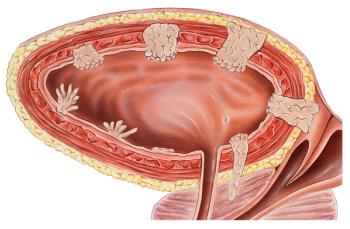
Oncology NEWS International
- Oncology NEWS International Vol 4 No 4
- Volume 4
- Issue 4
Osteosarcoma Chemo Regimens Debated
PARIS, France--Although the role of chemotherapy in the management of osteosarcoma was once controversial, a plethora of clinical studies now leave no doubt that chemotherapy dramatically brightens the outlook for patients with this disease.
PARIS, France--Although the role of chemotherapy in the managementof osteosarcoma was once controversial, a plethora of clinicalstudies now leave no doubt that chemotherapy dramatically brightensthe outlook for patients with this disease.
Still open to debate, however, is which drugs most improve disease-freesurvival, and whether chemotherapy is best administered beforeand after surgery or simply after surgery.
Two randomized multicenter studies conducted in the United Statesand Europe have recently tackled these thorny questions, and resultswere presented at the Fifth International Congress on Anti-CancerChemotherapy, along with details of new studies in progress.
The latest neoadjuvant therapy trial from the EORTC-MRC (the EuropeanOrganization for Research and Treatment of Cancer--Medical ResearchCouncil) randomized more than 400 osteosarcoma patients to receivedoxorubicin, 25 mg/m² on days 1 and 3, plus cisplatin (Platinol),100 mg/m² on day 1, every 3 weeks, or the modified T10a regimendeveloped at Me-morial Sloan-Kettering Cancer Center.
Dr. Allan van Oosterom, of the University of Antwerp (Belgium),reported that after a median follow-up period of 3.1 years, survivalin both patient groups was identical. The 5-year disease-freesurvival of roughly 60% compared favorably with previous resultsfrom the EORTC-MRC investigators and from other groups, he said.
Dr. van Oosterom stressed, however, that the doxorubicin-cisplatincombination offered equal efficacy at nearly a third the costof the more complicated polydrug T10a regimen.
The EORTC-MRC team rejected the inclusion of ifosfamide (Ifex)as a next step, for fear of possible side effects. Instead, theirnew study is comparing the tried-and-true doxorubicin-cisplatinregimen given every 3 weeks with a more intensified version givenevery 2 weeks, and supported with granulocyte colony-stimulatingfactor (G-CSF, Neupogen), 250 mcg/m² on days 1 to 10, and,when necessary, peripheral blood progenitor cell (PBPC) transplantation.
"We can tell from the experience with the first 100 patientsthat after the first four courses, you have to give peripheralstem cells back to achieve the desired doses," Dr. van Oosteromsaid. "The dose intensification with this new regimen isenormously greater than with our standard regimen." The EORTC-MRCinvestigators are shooting for a total of about 300 patients,and anticipate having their final results in about 2 years.
Dissenting Opinion
Another conference speaker, Dr. M.P. Link of Stanford University,believes that the verdict is not yet in on whether the theoreticaladvantages of neoadjuvant chemotherapy--earlier treatment of micrometastases,better chance of limb salvage thanks to tumor shrinkage, and theopportunity to test the tumor's drug sensitivity in vivo--outweighthe theoretical disadvantages of an increased risk of resistanceand delayed control of the primary tumor.
"In addition to its role in enhancing limb salvage surgery,presurgical chemotherapy has been popularized and recommendedas a strategy to improve the overall outcome of patients whetheror not they are candidates for limb-sparing operations, but thequestion remains whether it results in a superior cure rate, ascompared with the traditional approach of surgery followed byadjuvant chemotherapy," Dr. Link said.
Indeed, he argued, the results of studies featuring presurgicalchemotherapy are very similar to the outcomes reported in studiesof immediate surgery followed by chemotherapy with similarly intensive,multiagent regimens.
To directly determine whether preoperative chemotherapy confersa survival edge over postoperative chemotherapy, the PediatricOncology Group (POG) randomized 101 children with osteosarcomato receive chemotherapy either for 10 weeks before surgery andfor 32 weeks after surgery, or for 42 weeks starting 2 to 4 weeksafter surgery.
The POG regimen consisted of high-dose methotrexate, a doxorubicin-cisplatincombination, and a bleomycin (Blenoxane)-dactinomycin (Cosmegen)-cyclophosphamide(Cytoxan, Neosar) combination.
"Preliminary analysis indicates no advantage in terms ofevent-free survival for patients receiving presurgical chemotherapy,as compared with patients undergoing immediate surgery followedby chemotherapy," Dr. Link said. The projected 5-year event-freesurvival is 61% for patients assigned to neoadjuvant chemotherapyversus 67% for patients treated with the more traditional approach.
Noting that the outcome in both treatment groups was similar tothe results reported in the previous POG osteosarcoma trial, Dr.Link maintains that the administration of presurgical chemotherapyper se does not appear to improve the cure rate.
"Rather," he said, "recent improvements in outcomeprobably reflect the increasing intensity of the chemotherapyregimens utilized." The question of whether neoadjuvant chemotherapyactually improves the odds of limb salvage has yet to be addresseddirectly, he noted.
The ongoing Intergroup study being conducted jointly by POG andthe Children's Cancer Group is expected to enroll the majorityof American children who develop osteosarcoma within the next4 years, Dr. Link said.
Intergroup is randomizing these children to either standard adjuvantchemotherapy with high-dose methotrexate, doxorubicin, and cisplatin,or standard chemotherapy plus ifosfamide, and then randomizingthem again to receive or not receive liposome-encapsulated muramyltripeptide-phosphatidylethanolamine (MTP-PE).
Dr. Link explained that MTP-PE, a derivative of BCG, has beenshown to activate monocytes in vitro to a tumoricidal state againstosteosarcoma, and to eradicate established metastases and prolongsurvival in animals with osteosarcoma. "We have the prospectof identifying one or perhaps two new agents active against osteosarcoma,and since most of our survival curves are leveling off in theneighborhood of 65% to 70%, we certainly are in need of additionalactive agents," he said.
Articles in this issue
almost 31 years ago
First Results of Avicidin Trialsalmost 31 years ago
Chemo Patients Often Develop Menstrual Irregularitiesalmost 31 years ago
Growth Factor Receptor Blockade Moving From Laboratory to Clinicalmost 31 years ago
Controlled-Release AZT Gets FDA Go-Ahead for New Drug Investigationalmost 31 years ago
Vinorelbine Plus Chemo Promising in Advanced Diseasealmost 31 years ago
Bone Substudy a Part of Tamoxifen Prevention Trialalmost 31 years ago
Ultrasound Breast Screens Useful in Selected Womenalmost 31 years ago
New Roles Forecast for Endocrine Therapyalmost 31 years ago
Antisense Drug Against BCL-2 Effective in Animal Cancer Modelsalmost 31 years ago
Anticancer Drugs From Zeneca in Regulatory Phase of DevelopmentNewsletter
Stay up to date on recent advances in the multidisciplinary approach to cancer.


























































































